traction control Hyundai Matrix 2007 Owner's Manual
[x] Cancel search | Manufacturer: HYUNDAI, Model Year: 2007, Model line: Matrix, Model: Hyundai Matrix 2007Pages: 490, PDF Size: 12.81 MB
Page 12 of 490
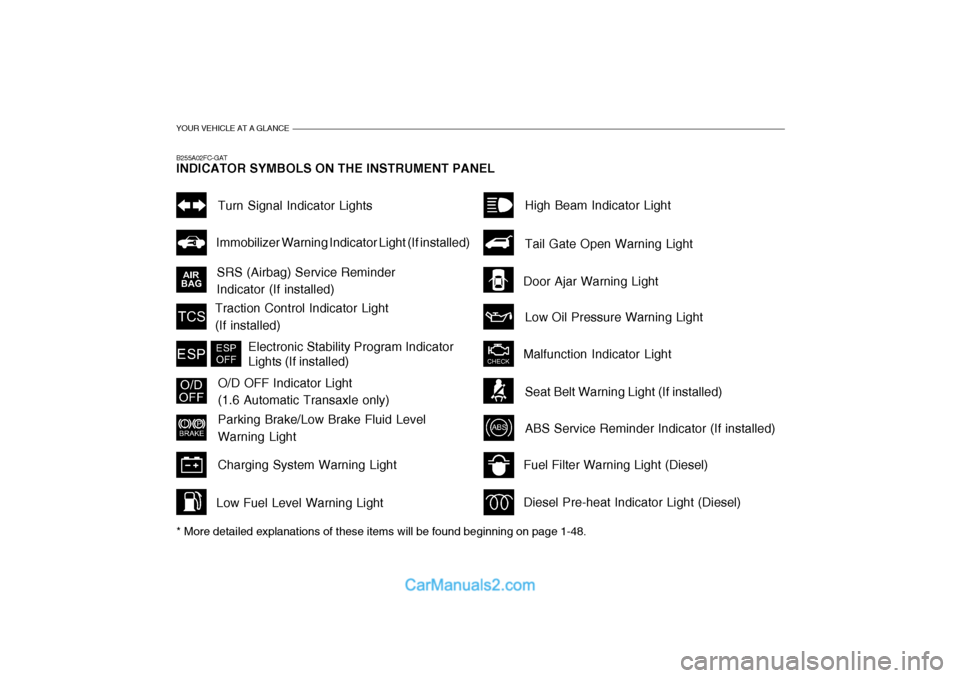
YOUR VEHICLE AT A GLANCE
B255A02FC-GAT INDICATOR SYMBOLS ON THE INSTRUMENT PANEL * More detailed explanations of these items will be found beginning on page 1-48.
SRS (Airbag) Service Reminder Indicator (If installed)Turn Signal Indicator Lights
Malfunction Indicator Light
Traction Control Indicator Light(If installed)
O/D OFF Indicator Light (1.6 Automatic Transaxle only)
Parking Brake/Low Brake Fluid Level Warning Light
Charging System Warning Light
Fuel Filter Warning Light (Diesel) Diesel Pre-heat Indicator Light (Diesel)
Immobilizer Warning Indicator Light (If installed)
ABS Service Reminder Indicator (If installed)
High Beam Indicator Light Low Oil Pressure Warning Light
Tail Gate Open Warning Light
Door Ajar Warning Light
Low Fuel Level Warning Light
Electronic Stability Program Indicator Lights (If installed)
Seat Belt Warning Light (If installed)
Page 57 of 490
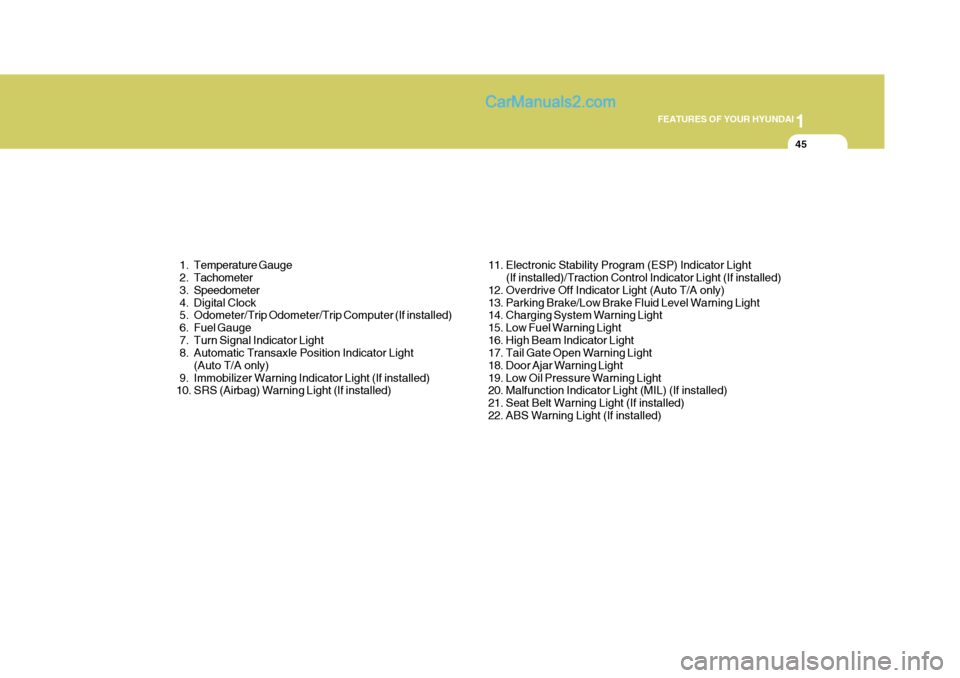
1
FEATURES OF YOUR HYUNDAI
45
1. Temperature Gauge
2. Tachometer
3. Speedometer
4. Digital Clock
5. Odometer/Trip Odometer/Trip Computer (If installed)
6. Fuel Gauge
7. Turn Signal Indicator Light
8. Automatic Transaxle Position Indicator Light (Auto T/A only)
9. Immobilizer Warning Indicator Light (If installed)
10. SRS (Airbag) Warning Light (If installed) 11. Electronic Stability Program (ESP) Indicator Light
(If installed)/Traction Control Indicator Light (If installed)
12. Overdrive Off Indicator Light (Auto T/A only)
13. Parking Brake/Low Brake Fluid Level Warning Light
14. Charging System Warning Light
15. Low Fuel Warning Light
16. High Beam Indicator Light
17. Tail Gate Open Warning Light
18. Door Ajar Warning Light
19. Low Oil Pressure Warning Light
20. Malfunction Indicator Light (MIL) (If installed)
21. Seat Belt Warning Light (If installed)
22. ABS Warning Light (If installed)
Page 59 of 490
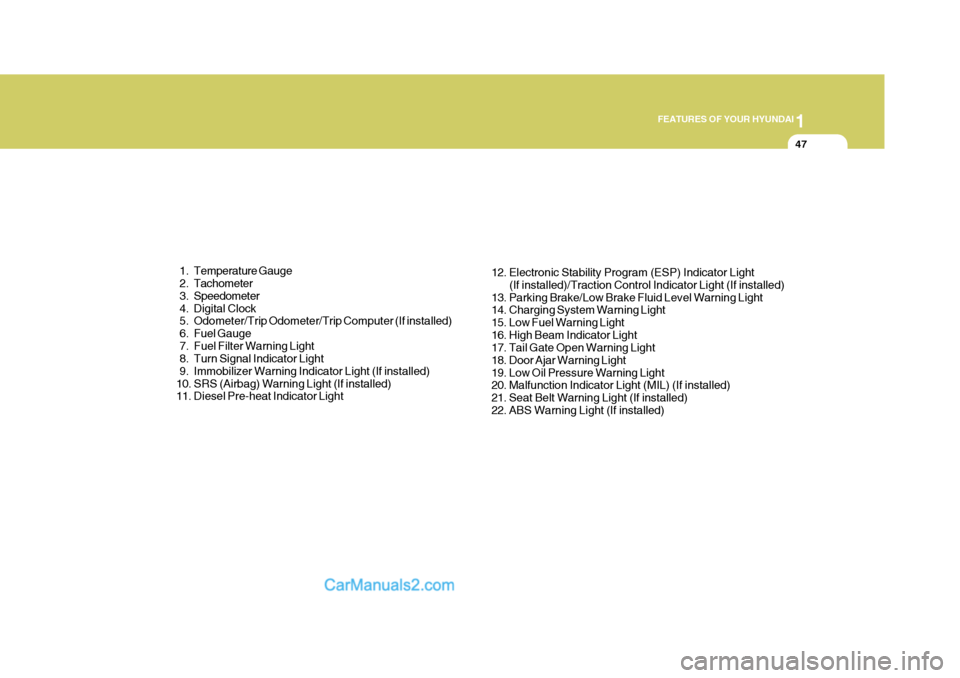
1
FEATURES OF YOUR HYUNDAI
47
1. Temperature Gauge
2. Tachometer
3. Speedometer
4. Digital Clock
5. Odometer/Trip Odometer/Trip Computer (If installed)
6. Fuel Gauge
7. Fuel Filter Warning Light
8. Turn Signal Indicator Light
9. Immobilizer Warning Indicator Light (If installed)
10. SRS (Airbag) Warning Light (If installed)
11. Diesel Pre-heat Indicator Light 12. Electronic Stability Program (ESP) Indicator Light
(If installed)/Traction Control Indicator Light (If installed)
13. Parking Brake/Low Brake Fluid Level Warning Light
14. Charging System Warning Light
15. Low Fuel Warning Light
16. High Beam Indicator Light
17. Tail Gate Open Warning Light
18. Door Ajar Warning Light
19. Low Oil Pressure Warning Light
20. Malfunction Indicator Light (MIL) (If installed)
21. Seat Belt Warning Light (If installed)
22. ABS Warning Light (If installed)
Page 60 of 490
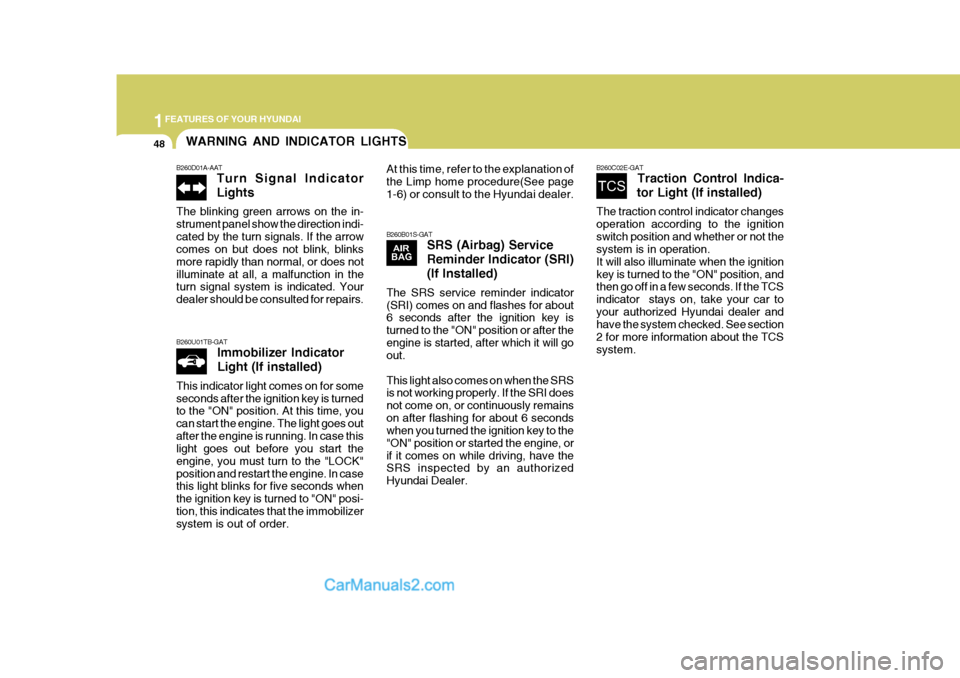
1FEATURES OF YOUR HYUNDAI
48WARNING AND INDICATOR LIGHTS
B260D01A-AAT Turn Signal Indicator Lights
The blinking green arrows on the in- strument panel show the direction indi-cated by the turn signals. If the arrow comes on but does not blink, blinks more rapidly than normal, or does notilluminate at all, a malfunction in the turn signal system is indicated. Your dealer should be consulted for repairs.
B260U01TB-GAT Immobilizer Indicator Light (If installed)
This indicator light comes on for some seconds after the ignition key is turned to the "ON" position. At this time, you can start the engine. The light goes outafter the engine is running. In case this light goes out before you start the engine, you must turn to the "LOCK"position and restart the engine. In case this light blinks for five seconds when the ignition key is turned to "ON" posi-tion, this indicates that the immobilizer system is out of order.
B260B01S-GAT SRS (Airbag) Service Reminder Indicator (SRI)(If Installed)
The SRS service reminder indicator (SRI) comes on and flashes for about 6 seconds after the ignition key is turned to the "ON" position or after theengine is started, after which it will go out. This light also comes on when the SRS is not working properly. If the SRI does not come on, or continuously remainson after flashing for about 6 seconds when you turned the ignition key to the "ON" position or started the engine, orif it comes on while driving, have the SRS inspected by an authorized Hyundai Dealer. B260C02E-GAT
Traction Control Indica-
tor Light (If installed)
The traction control indicator changesoperation according to the ignitionswitch position and whether or not the system is in operation. It will also illuminate when the ignitionkey is turned to the "ON" position, and then go off in a few seconds. If the TCS indicator stays on, take your car toyour authorized Hyundai dealer and have the system checked. See section 2 for more information about the TCSsystem.
At this time, refer to the explanation of the Limp home procedure(See page1-6) or consult to the Hyundai dealer.
Page 147 of 490

2
BEFORE STARTING THE ENGINE ........................... 2-3
KEY POSITIONS ......................................................... 2-4STARTING................................................................... 2-5
OPERATING THE MANUAL TRANSAXLE ................ 2-7
AUTOMATIC TRANSAXLE ......................................... 2-9ANTI-LOCK BRAKE SYSTEM (ABS)......................... 2-13
BRAKE TRACTION CONTROL SYSTEM (BTCS) .... 2-14
ELECTRONIC STABILITY PROGRAM (ESP) ...........2-16
DRIVING FOR ECONOMY .................... ....................2-18
SMOOTH CORNERING ............................................. 2-19
WINTER DRIVI NG ...................................................... 2-20
TRAILER OR VEHICLE TOWING.............................. 2-23
DRIVING YOUR HYUNDAI
2
Page 155 of 490
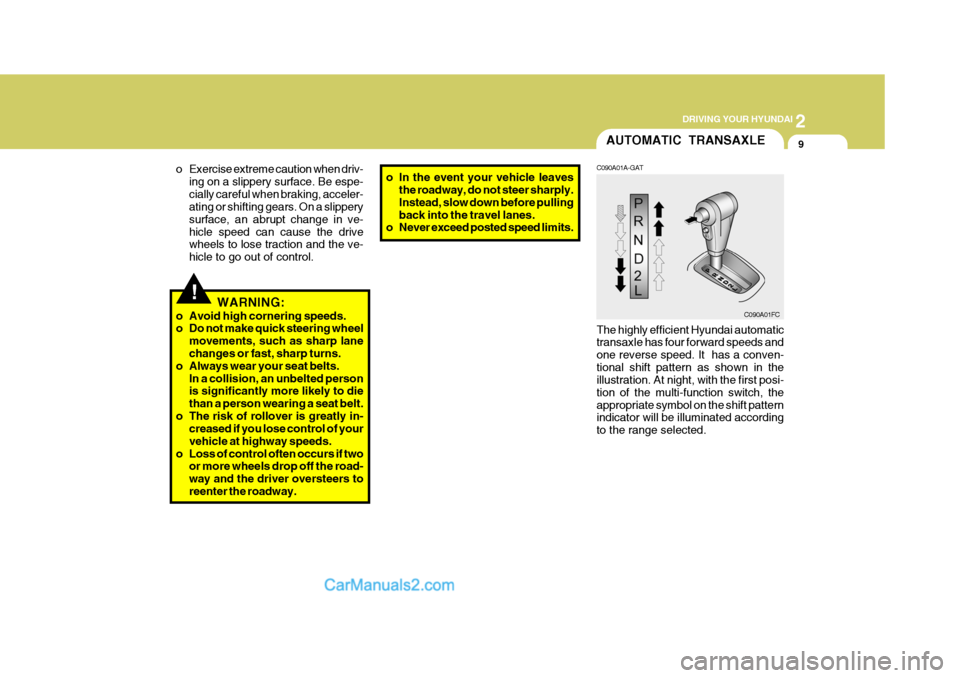
2
DRIVING YOUR HYUNDAI
9
!
o Exercise extreme caution when driv-
ing on a slippery surface. Be espe- cially careful when braking, acceler- ating or shifting gears. On a slippery surface, an abrupt change in ve-hicle speed can cause the drive wheels to lose traction and the ve- hicle to go out of control.
WARNING:
o Avoid high cornering speeds.
o Do not make quick steering wheel movements, such as sharp lanechanges or fast, sharp turns.
o Always wear your seat belts. In a collision, an unbelted personis significantly more likely to die than a person wearing a seat belt.
o The risk of rollover is greatly in- creased if you lose control of yourvehicle at highway speeds.
o Loss of control often occurs if two or more wheels drop off the road-way and the driver oversteers toreenter the roadway.o In the event your vehicle leavesthe roadway, do not steer sharply. Instead, slow down before pullingback into the travel lanes.
o Never exceed posted speed limits.
C090A01FC
The highly efficient Hyundai automatic transaxle has four forward speeds and one reverse speed. It has a conven-tional shift pattern as shown in the illustration. At night, with the first posi- tion of the multi-function switch, theappropriate symbol on the shift pattern indicator will be illuminated according to the range selected.
AUTOMATIC TRANSAXLE
C090A01A-GAT
Page 159 of 490
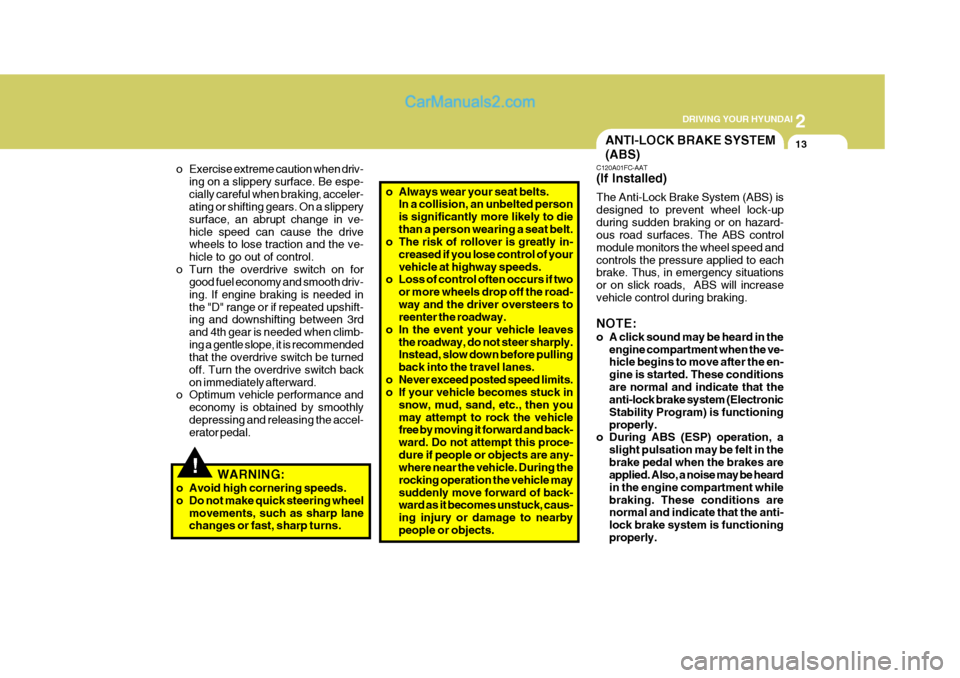
2
DRIVING YOUR HYUNDAI
13
!
o Exercise extreme caution when driv-
ing on a slippery surface. Be espe- cially careful when braking, acceler- ating or shifting gears. On a slippery surface, an abrupt change in ve-hicle speed can cause the drive wheels to lose traction and the ve- hicle to go out of control.
o Turn the overdrive switch on for good fuel economy and smooth driv-ing. If engine braking is needed inthe "D" range or if repeated upshift- ing and downshifting between 3rd and 4th gear is needed when climb-ing a gentle slope, it is recommended that the overdrive switch be turned off. Turn the overdrive switch backon immediately afterward.
o Optimum vehicle performance and
economy is obtained by smoothlydepressing and releasing the accel- erator pedal.
o Always wear your seat belts.In a collision, an unbelted person is significantly more likely to diethan a person wearing a seat belt.
o The risk of rollover is greatly in-
creased if you lose control of yourvehicle at highway speeds.
o Loss of control often occurs if two
or more wheels drop off the road-way and the driver oversteers to reenter the roadway.
o In the event your vehicle leaves the roadway, do not steer sharply.Instead, slow down before pulling back into the travel lanes.
o Never exceed posted speed limits.
o If your vehicle becomes stuck in snow, mud, sand, etc., then you may attempt to rock the vehicle free by moving it forward and back- ward. Do not attempt this proce-dure if people or objects are any- where near the vehicle. During the rocking operation the vehicle maysuddenly move forward of back- ward as it becomes unstuck, caus- ing injury or damage to nearbypeople or objects.
ANTI-LOCK BRAKE SYSTEM (ABS)
C120A01FC-AAT (If Installed) The Anti-Lock Brake System (ABS) is designed to prevent wheel lock-upduring sudden braking or on hazard- ous road surfaces. The ABS control module monitors the wheel speed andcontrols the pressure applied to each brake. Thus, in emergency situations or on slick roads, ABS will increasevehicle control during braking. NOTE:
o A click sound may be heard in the
engine compartment when the ve- hicle begins to move after the en- gine is started. These conditionsare normal and indicate that the anti-lock brake system (Electronic Stability Program) is functioningproperly.
o During ABS (ESP) operation, a
slight pulsation may be felt in thebrake pedal when the brakes are applied. Also, a noise may be heard in the engine compartment whilebraking. These conditions are normal and indicate that the anti- lock brake system is functioningproperly.
WARNING:
o Avoid high cornering speeds.
o Do not make quick steering wheel movements, such as sharp lane changes or fast, sharp turns.
Page 160 of 490
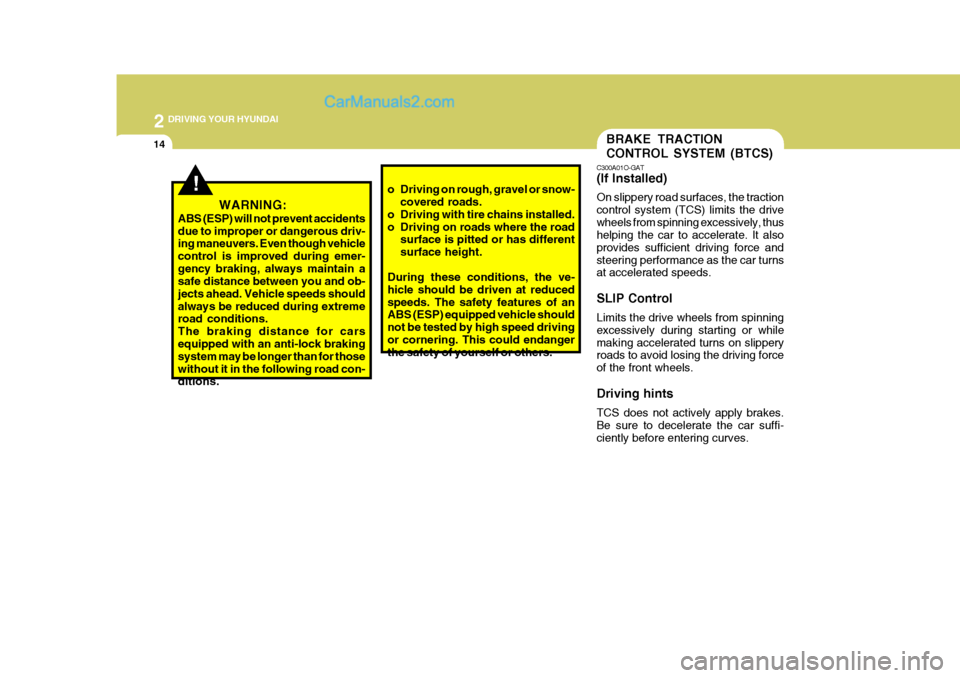
2 DRIVING YOUR HYUNDAI
14BRAKE TRACTION CONTROL SYSTEM (BTCS)
o Driving on rough, gravel or snow-
covered roads.
o Driving with tire chains installed.
o Driving on roads where the road surface is pitted or has differentsurface height.
During these conditions, the ve-hicle should be driven at reducedspeeds. The safety features of an ABS (ESP) equipped vehicle should not be tested by high speed driving or cornering. This could endanger the safety of yourself or others. C300A01O-GAT (If Installed) On slippery road surfaces, the traction control system (TCS) limits the drivewheels from spinning excessively, thus helping the car to accelerate. It also provides sufficient driving force andsteering performance as the car turns at accelerated speeds. SLIP Control Limits the drive wheels from spinning excessively during starting or whilemaking accelerated turns on slippery roads to avoid losing the driving force of the front wheels. Driving hints TCS does not actively apply brakes. Be sure to decelerate the car suffi-ciently before entering curves.!
WARNING:
ABS (ESP) will not prevent accidents due to improper or dangerous driv- ing maneuvers. Even though vehicle control is improved during emer-gency braking, always maintain a safe distance between you and ob- jects ahead. Vehicle speeds shouldalways be reduced during extreme road conditions. The braking distance for cars equipped with an anti-lock braking system may be longer than for thosewithout it in the following road con- ditions.
Page 161 of 490

2
DRIVING YOUR HYUNDAI
15
!
CAUTION:
When the TCS indicator blinks, SLIP control has been activated. It also means that the road is slippery or your car is accelerating excessively.In this situation, gently release foot pressure from the accelerator pedal and maintain moderate speed.
WARNING:
Traction control is only a driving aid; all normal precautions for driv- ing in inclement weather and onslippery driving surfaces should be observed.! C300D02O-GAT Indicator and Warning The TCS indicator should illuminate when the ignition key is turned to "ON"or "START", but should go out after three seconds. If the indicator does not illuminate,have it checked by an authorized Hyundai dealer. Should there be any unusual condi- tions in the device, TCS illuminates as a warning.If TCS illuminates, pull your car to a safe place and stop the engine. Then, start the engine again to checkif the TCS indicator goes out. If the indicator remains lit even after the engine has been started, haveyour car checked by an authorized Hyundai dealer. NOTE: When the TCS indicator illuminates, traction control is automatically de- activated for safety.
C300B01O-GAT TCS ON Mode In the TCS ON mode, the indicator in the instrument cluster will not be illumi-nated. NOTE:
1) Turn off the engine. Then restart
the engine, and the TCS mode will automatically turn "ON".
2) When the traction control is op-
erating properly, you can feel aslight pulsation in the vehicle. This is only the effect of brakecontrol and indicates nothing unusual.
3) When the engine starts, a click is heard from the engine compart-ment; however, this is only the sound of traction control beingchecked.
4) When moving out of the mud or
fresh snow, pressing the accel-erator pedal may not cause the engine speed to increase.
Page 255 of 490
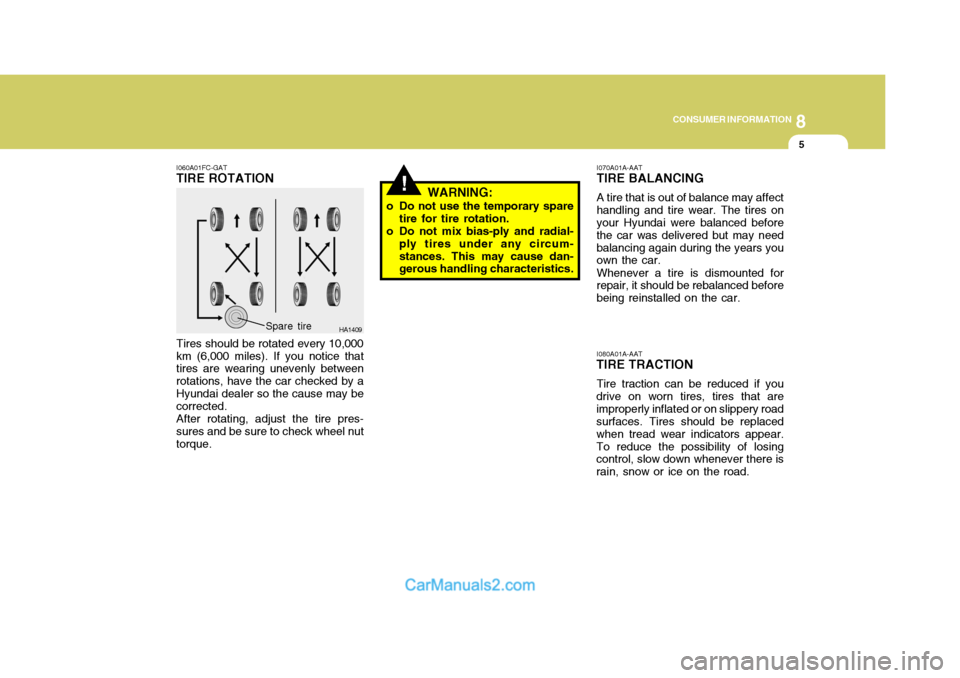
8
CONSUMER INFORMATION
5
!
I060A01FC-GAT
TIRE ROTATION
Tires should be rotated every 10,000 km (6,000 miles). If you notice that tires are wearing unevenly between rotations, have the car checked by aHyundai dealer so the cause may be corrected. After rotating, adjust the tire pres- sures and be sure to check wheel nut torque. HA1409
Spare tireWARNING:
o Do not use the temporary spare tire for tire rotation.
o Do not mix bias-ply and radial- ply tires under any circum- stances. This may cause dan- gerous handling characteristics. I070A01A-AAT TIRE BALANCING A tire that is out of balance may affect handling and tire wear. The tires on your Hyundai were balanced before the car was delivered but may needbalancing again during the years you own the car. Whenever a tire is dismounted for repair, it should be rebalanced before being reinstalled on the car. I080A01A-AAT
TIRE TRACTION
Tire traction can be reduced if you
drive on worn tires, tires that are improperly inflated or on slippery road surfaces. Tires should be replaced when tread wear indicators appear.To reduce the possibility of losing control, slow down whenever there is rain, snow or ice on the road.